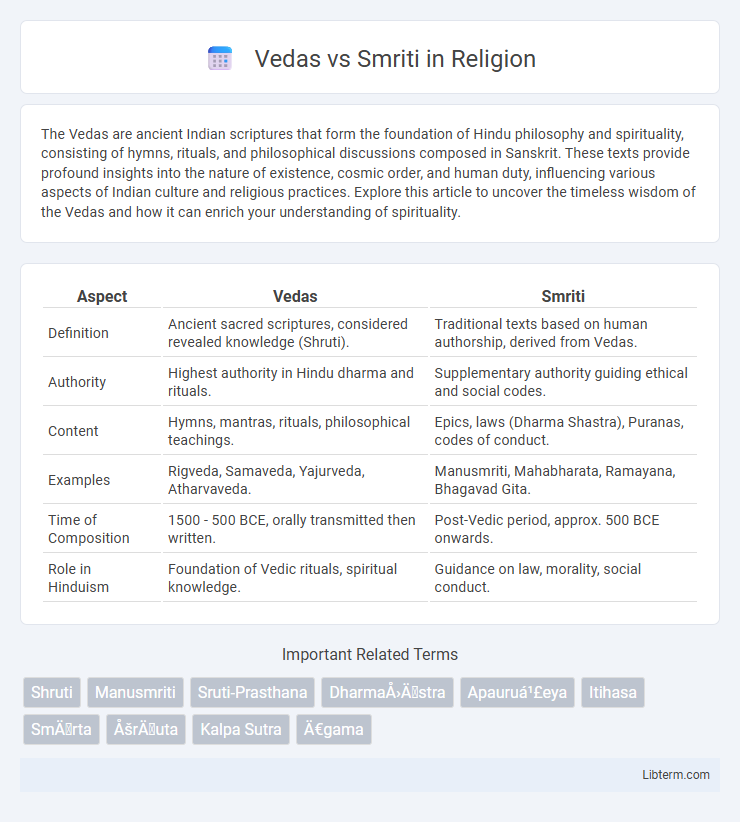The Vedas are ancient Indian scriptures that form the foundation of Hindu philosophy and spirituality, consisting of hymns, rituals, and philosophical discussions composed in Sanskrit. These texts provide profound insights into the nature of existence, cosmic order, and human duty, influencing various aspects of Indian culture and religious practices. Explore this article to uncover the timeless wisdom of the Vedas and how it can enrich your understanding of spirituality.
Table of Comparison
| Aspect | Vedas | Smriti |
|---|---|---|
| Definition | Ancient sacred scriptures, considered revealed knowledge (Shruti). | Traditional texts based on human authorship, derived from Vedas. |
| Authority | Highest authority in Hindu dharma and rituals. | Supplementary authority guiding ethical and social codes. |
| Content | Hymns, mantras, rituals, philosophical teachings. | Epics, laws (Dharma Shastra), Puranas, codes of conduct. |
| Examples | Rigveda, Samaveda, Yajurveda, Atharvaveda. | Manusmriti, Mahabharata, Ramayana, Bhagavad Gita. |
| Time of Composition | 1500 - 500 BCE, orally transmitted then written. | Post-Vedic period, approx. 500 BCE onwards. |
| Role in Hinduism | Foundation of Vedic rituals, spiritual knowledge. | Guidance on law, morality, social conduct. |
Introduction to Vedas and Smriti
The Vedas are ancient, authoritative scriptures central to Hinduism, composed in early Sanskrit and encompassing hymns, rituals, and spiritual knowledge foundational to Vedic tradition. Smriti texts, including the Dharma Shastras and epics like Mahabharata and Ramayana, are secondary scriptures written after the Vedas that interpret, elaborate, and apply Vedic principles to social laws and moral duties. While Vedas hold eternal, revealed knowledge (Shruti), Smriti serves as remembered tradition, adapting Vedic teachings to evolving cultural contexts.
Meaning and Etymology of Vedas
The Vedas, derived from the Sanskrit root "vid" meaning "to know," signify ancient texts embodying spiritual knowledge and wisdom foundational to Hinduism. In contrast to the Smriti, which are considered remembered traditions and secondary scriptures, the Vedas are regarded as apauruseya, or authorless, revealed knowledge with eternal authority. The semantic emphasis on Vedas highlights their role as primary, canonical scriptures encompassing hymns, rituals, and philosophical teachings essential for Vedic rituals and spiritual practice.
Meaning and Etymology of Smriti
Smriti, derived from the Sanskrit root "smr," meaning "to remember," encompasses a vast body of Hindu scriptures that serve as traditional memory, complementing the Vedas which are considered apauruseya or of divine origin. Unlike the Vedas, which are shruti or "heard" texts, Smriti literature includes laws, ethics, rituals, and stories authored by humans to interpret and apply Vedic knowledge practically. This distinction highlights Smriti's role in preserving cultural and societal norms through a dynamic and evolving textual tradition.
Historical Origins and Chronology
The Vedas, composed between 1500 and 500 BCE, are the oldest sacred texts of Hinduism, originating in the early Vedic period and considered apauruseya, or divinely revealed. Smriti literature, including texts like the Dharmashastras, Puranas, and epics such as the Mahabharata and Ramayana, emerged later from around 500 BCE to the early centuries CE, reflecting human authorship and evolving social norms. This chronological distinction highlights the Vedas' foundational role in establishing ritual and spiritual authority, while Smriti texts codify law, ethics, and mythology in response to changing historical contexts.
Key Texts of Vedas and Smriti
The key texts of the Vedas include the Rigveda, Samaveda, Yajurveda, and Atharvaveda, which consist of hymns, chants, rituals, and philosophical teachings fundamental to Hindu tradition. Smriti texts, such as the Manusmriti, Dharma Shastra, and the Puranas, provide guidelines on law, ethics, and social conduct, complementing the eternal knowledge of the Vedas. Vedas are considered Shruti, or revealed knowledge, while Smriti represents remembered and interpreted teachings, both crucial for understanding Hindu religious and cultural practices.
Authority and Divine Revelation
The Vedas hold supreme authority in Hinduism, considered eternal, apauruseya (not of human origin), and directly revealed (sruti) knowledge imparted by the divine. Smriti texts, including the Dharmasastras and epics, derive authority from the Vedas but are human compositions subject to interpretation and contextual adaptation. While Vedas establish fundamental spiritual principles, Smriti provides practical guidelines for societal and ritual conduct, reflecting evolving traditions.
Approach to Dharma in Vedas and Smriti
The Vedas approach Dharma as eternal, universal truths revealed through divine wisdom, emphasizing rituals, hymns, and cosmic order (Rta) as fundamental to upholding societal and moral laws. Smriti texts interpret Dharma as context-dependent duties, guided by social norms, customs, and ethical principles that evolve with time and circumstances. This distinction positions the Vedas as transcendent, scriptural authority, while Smriti serves as practical, adaptive guidelines for righteous living within specific communities.
Differences in Content and Style
The Vedas consist of ancient hymns, mantras, and rituals composed in precise, poetic meters central to Vedic ceremonies, reflecting an oral tradition emphasizing sacred knowledge and cosmic order. Smriti texts encompass diverse genres including law codes, epics, and philosophical treatises written in prose and verse, focusing on social duties, ethical guidelines, and narrative history. While the Vedas maintain a fixed, canonical form revered as apauruseya (authorless), Smriti works are dynamic, interpretative texts subject to adaptation across generations.
Influence on Hindu Law and Society
The Vedas serve as the foundational sacred texts in Hinduism, providing eternal spiritual knowledge that directly influences Hindu law's core principles. Smriti, derived from human authorship including texts like Dharmashastras and Manusmriti, offers practical guidelines and codified laws shaping social conduct and legal systems over time. Together, Vedas establish the divine authority, while Smriti adapts these precepts for societal governance, deeply impacting Hindu jurisprudence and cultural norms.
Contemporary Relevance and Interpretation
Vedas serve as the foundational scriptures of Hinduism, considered eternal and unchanging, offering spiritual knowledge and rituals, while Smriti texts provide interpretative guidance tailored to societal norms and ethics, adapting over time. Contemporary relevance emerges as scholars and practitioners navigate these texts to harmonize ancient wisdom with modern legal, ethical, and cultural frameworks. Interpretation of Smriti remains dynamic, reflecting evolving contexts, whereas Vedas uphold timeless principles central to spiritual identity and philosophical discourse.
Vedas Infographic

 libterm.com
libterm.com